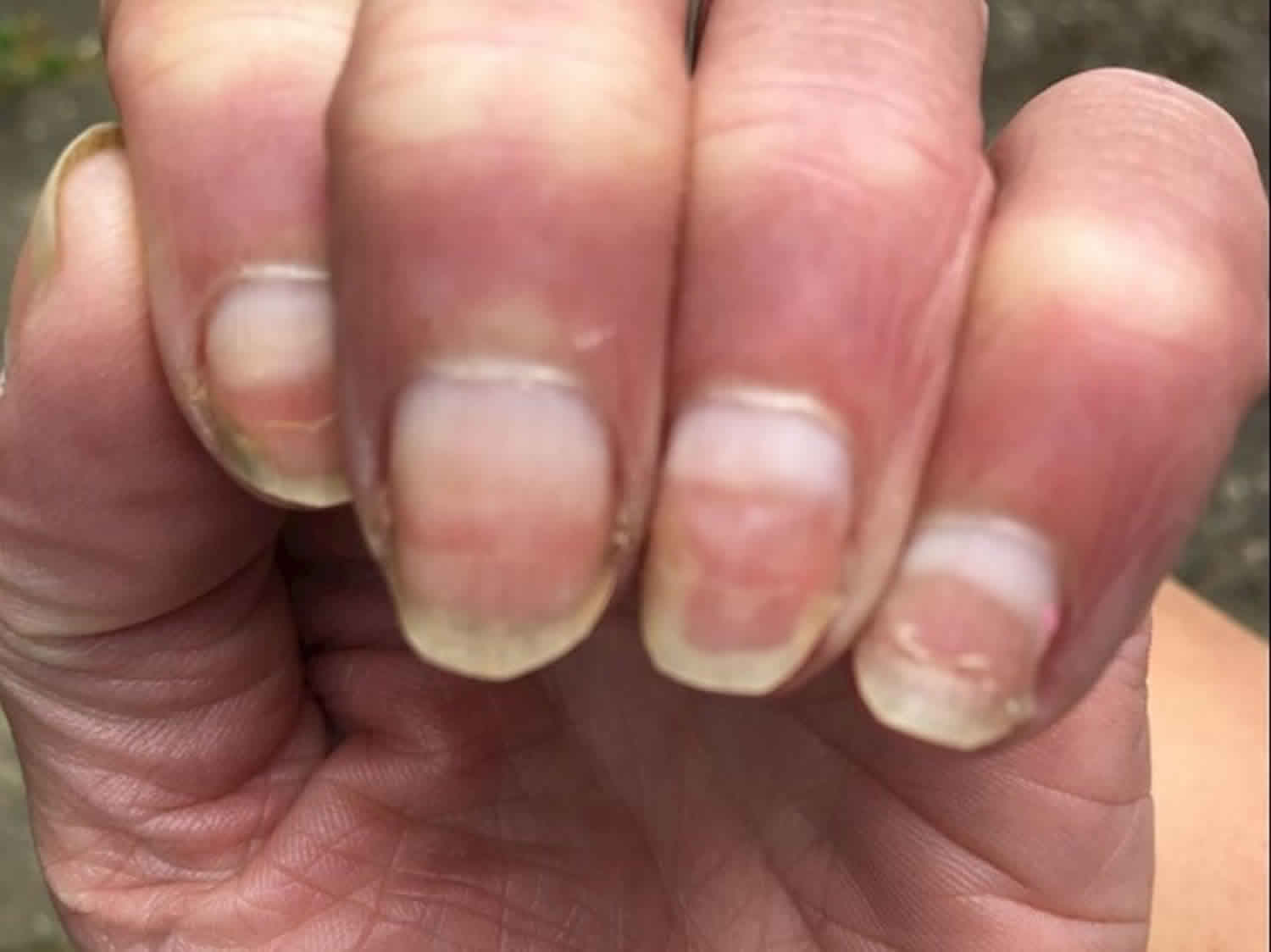Terry’s nails
Terry’s nails are white nails white except for a narrow pink band at the tip 1. Terry’s nails represent an “apparent leukonychia” as the whitened appearance of the nail is due to underlying defects in the nail bed 1. Terry’s nails are characterized by ground glass opacification of nearly the entire nail, obliteration of the lunula, and a narrow band of normal, pink nail bed at the distal border. Terry’s nails can sometimes be attributed to aging. In other cases, Terry’s nails can be a sign of a serious underlying condition, such as liver disease (cirrhosis or primary sclerosing cholangitis), congestive heart failure, kidney failure or diabetes 2.
Figure 1. Terry’s nails with leukonychia of the proximal and pinkish bands at the distal area of all fingernails
Footnote: Terry’s nails. A classic presentation of Terry’s nails demonstrating ground glass opacification of nearly the entire nail with A – No visible lunula and B – A narrow band of normal, pink nail bed at the distal border
Terry’s nails causes
Terry’s nails can sometimes be attributed to aging. In other cases, Terry’s nails can be a sign of a serious underlying condition, such as liver disease (cirrhosis or primary sclerosing cholangitis), congestive heart failure, kidney failure or diabetes.
Although the pathophysiology of Terry’s nails remains undetermined, a change in nail bed vascularity in particular distal telangiectasias 3, secondary to overgrowth of connective tissue, is thought to be responsible 4. Nail bed biopsies, which revealed telangiectasias in the distal band, further support microvascular involvement 5.
Terry’s nails differential diagnosis
The differential diagnosis for Terry’s nails includes uremic half-and-half nails also known as Lindsay’s nails typically seen in chronic renal diseases, Muehrcke’s nails, and true leukonychia totalis/partialis 1. Although both Terry’s nails and half-and-half nails (Lindsay’s nails) can be seen in patients with chronic renal disease and are characterized by ground glass opacities, half-and-half nails are distinct in that only about half of the proximal nail bed is opacified 6. Like Terry’s nails, Muehrcke’s nails are a disorder of the nail bed and can be a reflection of systemic disease 7. However, Muehrcke’s nails have a distinct pattern of paired, white, transverse lines that typically spare the thumbnail and are usually seen in association with hypoalbuminemia and chemotherapy 7. Moreover, the pathological changes in Muehrcke’s nails are reversible with a rise in serum albumin 8. On initial inspection, true leukonychia may mimic Terry’s nails; however, true leukonychia involves the nail plate rather than the nail bed 9. Therefore, unlike Terry’s nails, which retain the proximal nail discoloration as the nails grow outward, a true leukonychia will grow out with the nail 10. Neapolitan nails, or white nails associated with old age, may also Wresemble half-and-half nails 11.
Terry’s nails treatment
Terry’s nails can occur with normal aging, Terry’s nails can also be an indication of an underlying medical condition, most notably, cirrhosis, chronic renal failure, diabetes and congestive heart failure. Terry’s nails treatment involves treating the underlying cause.
References- Witkowska AB, Jasterzbski TJ, Schwartz RA. Terry’s Nails: A Sign of Systemic Disease. Indian J Dermatol. 2017;62(3):309–311. doi:10.4103/ijd.IJD_98_17 https://www.ncbi.nlm.nih.gov/pmc/articles/PMC5448267
- Meegada S, Verma R. Terry’s nails. Clin Case Rep. 2020;8(2):404–405. Published 2020 Jan 17. doi:10.1002/ccr3.2671 https://www.ncbi.nlm.nih.gov/pmc/articles/PMC7044363
- Holzberg M. & Walker H.K. Terry’s nails: revised definition and new correlations. Lancet. 1984; 1: 896-899
- Patel LM, Lambert PJ, Gagna CE, Maghari A, Lambert WC. Cutaneous signs of systemic disease. Clin Dermatol. 2011;29:511–22.
- Nia AM, Ederer S, Dahlem KM, Gassanov N, Er F. Terry’s nails: a window to systemic diseases. Am J Med. 2011;124(7):602–604. doi:10.1016/j.amjmed.2010.11.033 https://www.amjmed.com/article/S0002-9343(11)00257-9/fulltext
- Gandhi K, Prasad D, Malhotra V, Agrawal D. Half-and-half nails. Indian J Nephrol. 2014;24:330.
- Muehrcke Lines of the Fingernails. https://emedicine.medscape.com/article/1106423-overview
- Singal A, Arora R. Nail as a window of systemic diseases. Indian Dermatol Online J. 2015;6:67–74.
- Kim SW, Kim MS, Han TY, Lee JH, Son SJ. Idiopathic acquired true leukonychia totalis and partialis. Ann Dermatol. 2014;26:262–3.
- Chesnut G, Taylor S, Belin E. What is your diagnosis? Mees lines and Beau lines. Cutis. 2013;91:147–150. 1.
- Khichar S, Choudhary S. Terry nails in a patient with chronic alcoholic liver disease. Cleve Clin J Med. 2014;81:603–4.







